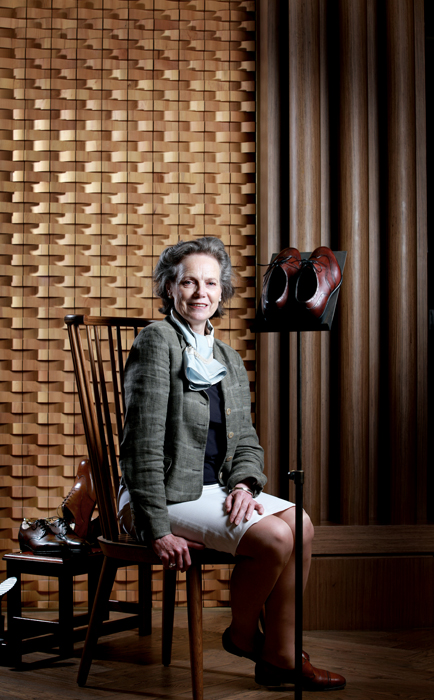
Most readers of An Uptown Dandy know that I'm a big fan of Edward Green shoes. So I considered myself very lucky to meet Hilary Freeman in person at the MRket show in New York City back in January (I was there to interview the folks from Grenfeld, and Edward Green happened to be located in the next booth). I was pleasantly surprised to find that they remembered the Windsors that I sent back to the factory for refurbishment, and its always a treat to talk talk shoes with such knowledgeable individuals. Here, then, is part one of a brief Q&A on all things EG with Hilary Freeman, Managing Director of Edward Green.
Can you tell us a bit about your background? How did you come to play such a prominent role at one of Northampton's most respected shoemakers?
I worked for many years in Paris: it was surely this which inspired my total appreciation of quality. When I returned to London, I asked friends to recommend a good dry cleaner and shoe repairer and was told to my horror, "We throw them away!" I worked in areas as diverse as Cosmetics with Revlon International and in New Product Development with Sainsbury's. So then I came back to work at Edward Green having met John, who owned the business.
How did you first meet John Hlustik?
We met in London at the wedding of a mutual friend.
What was the company like when Mr. Hlustik first arrived?
Edward Green, under the ownership since 1979 of an American who lived in New York, was failing. John Hlustik, a renowned shoe designer with offices in Kilmarnoch, Savile Row, London and Florence, visited the Edward Green factory at the behest of the American and fell in love with it. In 1982 when the company was virtually bankrupt, John flew to JFK and bought Edward Green for GBP 1.00 (plus the debts!). He wanted to design for himself rather than, as he had designed before, for others. Rather than compete with the larger Northampton shoe manufacturers making typically black Goodyear Welted city shoes, as John Church told me: John Hlustik made Brown shoes and later slip-on shoes, acceptable. He developed the process of 'antiquing shoes.': thereby countering advice which traditionally stipulated 'not Brown for Town'.
Edward Green's Windsor, 201 Last.
As you know, I'm a big fan of some of Edward Green's models from the 1980s, particularly the Windsor and Braemar models with their distinctive, unique broguing patterns. I've always associated these shoes with the creativity and imagination of Mr. Hlustik. Can you shed any light on whether these designs were inspired from styles found in the Edward Green archives?
There are certainly shoes very similar to these from the archive. Over the years shoes are re-made in subtly different ways, on different lasts or in different skins changing the character a little. So for instance recently we remade the Windsor but with slightly less ornate broguing. Broguing became more popular in the 1920s - one theory is that war machinery led to a degree of mechanization in brogue punching and this led to increasingly intricate patterns being used. Certainly we think that the thistles and decorative patterning goes back to that period - and John reintroduced it on particular models in the 1980s.
When comparing vintage Edward Green shoes to more recent offerings, the most notable different, after the subtle evolution of the lasts, seems to be the introduction of the burnished calf leather "look," particularly at the toe cap and the rear quarters. Is that due to technological improvements/ advancements over the years, or simply a response to customer demand/preference? I love it, by the way.
Well, John developed our antiquing years ago having studied shoe design in Italy. He wanted to create a deep patina - an antiqued look embodying the cared for appearance of the shoes his grandfather would have worn. This gave the company a niche away from the seas of black shoes made by the other Northampton businesses at the time. Whether for the classic 'Edwardian' or 'Chestnut', the same technique can be used on our more recent 'Cloud' to create a striking and modern look. Either way, it's the signature of Edward Green, gives real depth to the shoe and requires the very finest calf leather and meticulous hand-finishing as the base tan is light and the character of the skin is so evident.
Most admirers of Edward Green will be familiar with the wonderful variety of models available via the ready-to-wear. Can you tell us a bit more about the "Made-to-Order" and "Top Drawer" programs? How would you describe your target customer for these programs?
Men who buy Edward Green are men with a real appreciation for quality and attention to detail. They want something special. It may be that they want to have a particular shoe created in a particular colour - or it may be that they've found a last that particularly suits their foot and want want to buy their shoes based on that. So there is a combination of different variables - leather, pattern, last, sole, welt, lining, etc., which can be specified. Top Drawer shoes have a different level of finish - exquisite, with a tightly bevelled waist, a London heel tapered a little like a classic bespoke shoe. Most of the making is done by a single experienced cordwainer. The waist of the shoe can be monogrammed with fine nails. And there's an even greater degree of customization, which allows for pattern changes, for example.
To Be Continued . . .



No comments:
Post a Comment